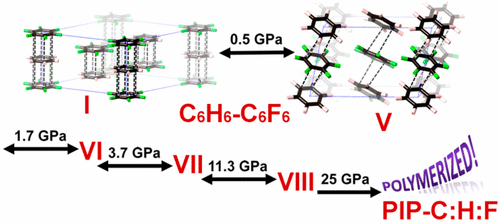当前位置:
X-MOL 学术
›
J. Phys. Chem. C
›
论文详情
Our official English website, www.x-mol.net, welcomes your
feedback! (Note: you will need to create a separate account there.)
Phase Transitions and Polymerization of C6H6–C6F6 Cocrystal under Extreme Conditions
The Journal of Physical Chemistry C ( IF 3.3 ) Pub Date : 2016-12-16 00:00:00 , DOI: 10.1021/acs.jpcc.6b11245 Yajie Wang 1 , Lijuan Wang 1 , Haiyan Zheng 1 , Kuo Li 1 , Michał Andrzejewski 2 , Takanori Hattori 3 , Asami Sano-Furukawa 3 , Andrzej Katrusiak 2 , Yufei Meng 1 , Fuhui Liao 4 , Fang Hong 1 , Ho-kwang Mao 1, 5, 6
The Journal of Physical Chemistry C ( IF 3.3 ) Pub Date : 2016-12-16 00:00:00 , DOI: 10.1021/acs.jpcc.6b11245 Yajie Wang 1 , Lijuan Wang 1 , Haiyan Zheng 1 , Kuo Li 1 , Michał Andrzejewski 2 , Takanori Hattori 3 , Asami Sano-Furukawa 3 , Andrzej Katrusiak 2 , Yufei Meng 1 , Fuhui Liao 4 , Fang Hong 1 , Ho-kwang Mao 1, 5, 6
Affiliation

|
Pressure-induced polymerization (PIP) of aromatic molecules can generate saturated carbon nanostructures. As a strongly interacted π–π stacking unit, the C6H6–C6F6 adduct is widely applied in supramolecular chemistry, and it provides a good preorganization for the PIP. Here we investigated the structural variation of C6H6–C6F6 cocrystal and the subsequent PIP process under high pressure. Four new molecular-complex phases V, VI, VII, and VIII have been identified and characterized by the in situ Raman, IR, synchrotron X-ray, and neutron diffraction. The phase V is different from the phases observed at low temperature, which has a tilted column structure. Phases VI and VII have a structure similar to phase V. Phase VIII polymerizes irreversibly upon compression above 25 GPa without any catalyst, producing sp3(CH/F)n materials. The π–π interaction is still dominant below 0.5 GPa but is most likely to be overstepped under further compression, which is important for discussing the supramolecular phase transition and the polymerization process.
中文翻译:

C 6 H 6 –C 6 F 6共晶体在极端条件下的相变和聚合
芳族分子的压力诱导聚合(PIP)可以生成饱和的碳纳米结构。作为强相互作用的π-π堆积单元,C 6 H 6 -C 6 F 6加合物广泛应用于超分子化学中,并为PIP提供了良好的预组织。在这里,我们研究了C 6 H 6 –C 6 F 6的结构变异共晶和随后的高压下PIP工艺。通过原位拉曼光谱,红外光谱,同步加速器X射线和中子衍射,鉴定并表征了四个新的分子复合物相V,VI,VII和VIII。相V不同于在低温下观察到的相,该相具有倾斜的柱状结构。阶段VI和VII具有类似于阶段V的结构。阶段VIII在压缩至25 GPa以上且无任何催化剂的情况下不可逆地聚合,生成sp 3(CH / F)n材料。在0.5 GPa以下,π-π相互作用仍然占主导地位,但在进一步压缩下很可能被超越,这对于讨论超分子相变和聚合过程很重要。
更新日期:2016-12-16
中文翻译:

C 6 H 6 –C 6 F 6共晶体在极端条件下的相变和聚合
芳族分子的压力诱导聚合(PIP)可以生成饱和的碳纳米结构。作为强相互作用的π-π堆积单元,C 6 H 6 -C 6 F 6加合物广泛应用于超分子化学中,并为PIP提供了良好的预组织。在这里,我们研究了C 6 H 6 –C 6 F 6的结构变异共晶和随后的高压下PIP工艺。通过原位拉曼光谱,红外光谱,同步加速器X射线和中子衍射,鉴定并表征了四个新的分子复合物相V,VI,VII和VIII。相V不同于在低温下观察到的相,该相具有倾斜的柱状结构。阶段VI和VII具有类似于阶段V的结构。阶段VIII在压缩至25 GPa以上且无任何催化剂的情况下不可逆地聚合,生成sp 3(CH / F)n材料。在0.5 GPa以下,π-π相互作用仍然占主导地位,但在进一步压缩下很可能被超越,这对于讨论超分子相变和聚合过程很重要。


















































 京公网安备 11010802027423号
京公网安备 11010802027423号